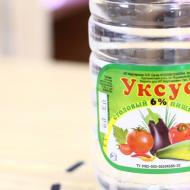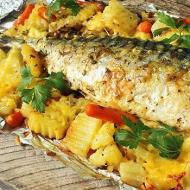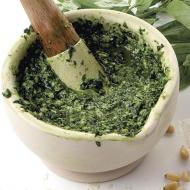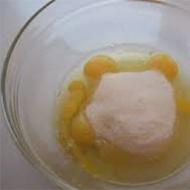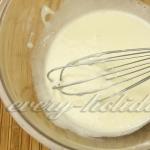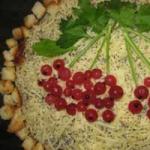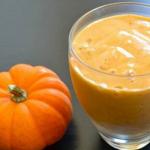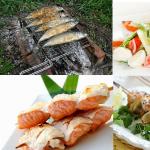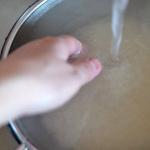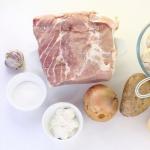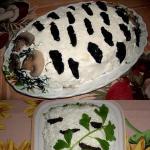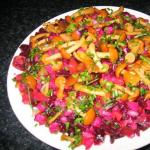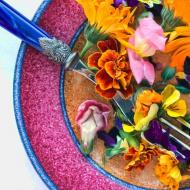
Edible and poisonous plants. Poisonous plants (photos with descriptions). How to determine which berries are edible
When there was nothing to eat in the spring, my husband brought me a plate of beautiful flowers and said: try it.
I was pregnant and nursing at the same time, after the most difficult winter of my life.
Throughout May and June, every day we ate white acacia flowers, mouse peas, forest violets and dandelions - with salt and sunflower oil. In our greenhouse, greenery grew, followed by vegetables, but compared to flowers, we no longer wanted them. With spring came new youth, and this was incomprehensible to me: health returned unexpectedly quickly, the body was cleansed and filled with everything it needed. We set up an ecological agricultural farm on our site with homemade drip irrigation from solar panels, painted pictures and wrote music, erected buildings, planted trees, fried omelettes for guests from bunches of flowering acacia, chased the neighbor’s mischievous goats - we had enough energy for everything, and a lot of things made us happy.
Later, turning to reference literature, I discovered a lot of interesting things about the healing and nutritional value of a living flower.
What is a flower?
A flower is the reproductive organ of a plant, the place where its seeds, future generations like it, its children, ripen. And we give our best to children. That is why healers rush to collect herbs before the first buds open, because by the time of flowering the most valuable substances rise into the flower, and the leaves of the plant no longer retain the same rich smell and healing power.
The flower is so small, so light, and the content of useful elements in it is colossally high:
Juice and live fiber
Pollen – male hormones
Nectar – unprocessed honey of the first freshness
Enzymes – make food easier to digest
Protein – for muscle development
Essential oils are natural aromas that give others peace and subtle sensory experiences.
Antioxidants – substances that stop aging
A flower is the maximum concentration of the vital forces of a plant, a living vitamin incomparable in its usefulness, a powerful flow of healthy energy.
Do you remember how, as a child, on a lilac bush, among many flowers with four petals, we looked for the only one with five, and ate it to become an excellent student?
Do adults do this? Yes, they do it professionally! Try edible flowers, let newness and youth into your life.
Who knows, perhaps somewhere far away at the same time as you, the German Peter Knacke, who carefully grows fifty species of edible flowers for the best restaurants in Spain in wind-protected greenhouses, will gently stroke a bee with his finger on a sunny mustard flower, or suddenly the ardent Italian Fabrizio Fatucci will pick a nasturtium bud, the freezing chef of the Gusto restaurant in St. Petersburg.

World-famous chefs use edible flowers, reviving forgotten traditions and creating new dishes: desserts, cocktails, confitures. This is a trend of haute cuisine [from kuizin] - fr. haute cuisine, just as haute couture is haute couture.
It is impossible to imagine Italian cooking without yellow gramophone flowers of pumpkin and zucchini, and Indian cuisine without rose petals.
We have all ever eaten broccoli or cauliflower, and never even thought that these are also flowers, such large, nutritious, dietary inflorescences.
How many other types of edible flowers are there? So many. And each has its own unique taste and healing properties.
Why do we know so little about flowers? How is it that we humans have forgotten about them?
Eating flowers is a centuries-old tradition. There is historical evidence that the peoples of ancient Rome, Greece, Japan, China, Libya, India, the Aztecs, and, of course, our ancestors the Slavs - peoples who lived thousands of years ago in various territories of the planet Earth, independently knew and ate flowers. As time passed, trade, transport, and navigation developed, and with the opening of the waterway to India, flowers lost their popularity as seasonings for people of the upper classes, their place was taken by imported spices: cinnamon, ginger, turmeric, cumin, saffron, black pepper. Imported wonders and new edible plants began to appear, and over time, other dishes with flowers also disappeared, they became unfashionable food for the poorest segments of the population. This is how we lost the culture of eating flowers.
Flowers became popular again in the 80s of the 20th century and remain in demand to this day, but not as everyday food, but as a delicacy.
On Asian restaurant menus, flowers are listed as an expensive, exclusive dish. Asians are far ahead of us in the philosophy and culture of edible flower consumption. But our land is so rich in plants full of life. How can we not create a rainbow of petals in a salad bowl with our own hands, if even in cold St. Petersburg the Italian Fabrizio Fatucci finds fresh flowers for his culinary masterpieces. The chef of the Gusto restaurant and the head of the Gustomaestro culinary school, the author of the book “My Italian Cuisine: From Classic to Modern,” writes in his Internet diary, full of expression and professional discoveries:
“And the big news is, I finally found edible flowers. I've been looking for them in Russia for 6 years now and finally found them. I am convinced that cooking is an absolute art, and what gives me the most pleasure is the aesthetics of the dish. You can’t imagine what a “taste for life” I experience when I play with the colors that nature offers me. Putting a chamomile petal on the scallops that rest on the purple potato cream, adding a slice of blood orange and dressing everything with extra virgin olive oil is poetry and passion for me! A thousand times better than all other pleasures!!! At least for me!"
German Peter Knacke created an ecological farm in Spain. He is a supplier to the best restaurants, growing about 50 types of edible inflorescences, all of the inflorescences are collected only by hand. Care is important at every stage - from disembarkation to collection and sorting. For this reason, Finca is completely chemical-free. After harvesting, the inflorescences are immediately packaged and cooled. This way they can be stored for up to 7 days.
Each flower tastes like a revelation.
Also, the culture of eating flowers has become very popular among tourists, because it is convenient and joyful to enjoy nature’s bounty while traveling. Once in a different climate zone, you may find yourself among unfamiliar plants. In this case, you should act carefully, use encyclopedic knowledge and observe what plants people and animals - the indigenous inhabitants of this region - choose for food, and try everything new in small quantities.
The fresher the flower, the healthier it is. Therefore, it is good to be able to independently collect flowers for ourselves, since we feel that at the moment it will be useful for us. And yet, we can express our tenderest love and care to our loved ones by collecting edible flowers especially for them, with kind thoughts and feelings.
How we collect flowers is important. Incredibly, but it has been tested many times: the flowers, herbs, fruits that we collect absorb our thoughts, feelings, and also everything that we perceive around us: the beauty of endless distances, the blow of the wind, the shine of the wings of a ladybug, drops of dew on web. It is important to take your mind off thoughts about work, and for some, singing helps with this, for others, watching the breath, praying or reading mantras.
When picking a flower or healing sprout, to enhance the effect, you can recite its healing properties out loud: this is for vigor, this is for joint flexibility, this is for muscle strength, this is for cleansing, this is for vigilance of the eyes... If you come across an edible flower, the gifts of which are for you unknown - improvise, come up with a good wish for each flower on the fly: “for joy, for happiness, for health, for love!” A walk to pick flowers calms you down and fills you with fresh energy, making you calmer and more resilient.
In India, they practice healing with the beauty and scents of flowers, healing sleep on a bed of petals, wearing garlands of flowers and applying flowers to various parts of the body. For Chinese healers, it is not the smell of a flower that is important, but its color: red roses create an energy boost, blue bells help you sleep.
Dr. Edward Bach developed the Flower Therapy technique, which allows you to work not only with physical health, but also with mental states, to live easier and let go of feelings of guilt, fear, resentment, and moreover: to get rid of unwanted character traits and habits: learn to say at the right moment “no”, the esthete should become more tolerant of people, be able to learn life lessons the first time, restore faith in the future, care without expecting a reward, dispel sadness about the past, calmly and confidently withstand a stressful situation. How deeply this man observed the flowers!
You can focus on the flower and observe your feelings and condition - thus learning more about both the plant and yourself. The flower changes its appearance throughout the day, and looks completely special during sunrise and sunset.
In the meadow, in the forest, in the garden, in the vegetable garden, and even on the balcony. But we definitely won’t go to a bouquet shop, to a city flowerbed, or to the side of the road: we need environmentally friendly flowers.
We can use what we have collected as a sweet dessert, seasoned with honey, freshly squeezed juice or fruits ground in a blender (melon, apple, peach), or as a salad, seasoned with tomato, oil, vinegar, salt, and spices.
The lifespan of a flower is very short. Therefore, the flowers are always clean, and, with rare exceptions, they do not need to be washed - but can be eaten immediately.
New plants should be consumed in the smallest quantities so that the body gets used to it and toxicity does not occur, especially for city dwellers. The reaction of each person is individual, depending on the presence of a tendency to allergies and sludge in the body.
Pictures with edible flowers





EDIBLE FLOWERS IN THE FOREST:
White acacia (Robinia false acacia) is the nurse and savior of arid regions, the pioneer of the desert, the Gorynych serpent among the trees: in the place of the cut trunk, several new living shoots quickly rise from the roots. In salads, omelettes, soups and teas. Acacia inflorescences are large and easy to collect. Attention! Yellow acacia is poisonous!
Linden: nectar-rich flowers are perfect for salad, jam, tea
Pine pollen is a powerful healing and vitamin remedy, even used for pulmonary tuberculosis. For storage it must be well dried. Young pine cones can be eaten as a vitamin, they have a sour taste due to the high content of ascorbic acid
Willow and birch catkins are also flowers, they are edible and rich in vitamins
Chestnut: the flowers of some types of chestnut heal blood vessels and invigorate, like coffee. Can be eaten in very small quantities
Wild violet, sweet and tender, cleanses the blood and has an anti-inflammatory effect on the throat, teeth, skin, and joints. The ancient Romans used violet for hangovers. It is eaten raw, candied, made into jellies, desserts, and added to tea. House violet is also edible
Wild onions: leaves and inflorescences, raw and salted, are placed in salads, added to any side dish, used in the preparation of hot dishes, pies and other things. Arrows of flowers are pickled like wild garlic
Goose onion (bird onion, heyjia) is an early spring primrose, an ephemeral from the lily family. It can be found in the forest and meadow. Used in folk medicine, eaten raw and boiled
Forest geranium has hemostatic and astringent effects.
Meadowsweet (meadowsweet): sweet and aromatic, for drinks (teas, liqueurs). Natural aspirin. Carefully! There are poisonous plants similar to meadowsweet.
Veronica officinalis (oak tree): the tops of the plant with leaves and flowers are collected at the beginning of flowering. Used as a natural flavoring agent for drinks
And also: heather (brewed as tea), lingonberry (in tea, has a diuretic effect), strawberry, rose hip
IN THE MEADOW:
Dandelion: The flowers are used in salads and garnishes and to make dandelion honey and wine. Many times healthier than any greens from the garden
Clover (clover) grows everywhere, all types of clover are edible. The flowers can be eaten raw or steeped in hot water as tea. Greens taste better when cooked.
Chicory: The entire wild plant, including the flowers, can be eaten.
Blueberry is a generous honey plant; the flowers are edible along with the leaves and young shoots.
Lungwort - edible and nutritious
Sweet clover (yellow) is a spicy, salad, very affordable plant that blooms all summer. It is delicious raw, and the drink sbiten with honey is also prepared from it. White clover can be tried carefully, little by little, as a choleretic agent. The smell and properties are similar to chamomile
Sainfoin improves men's and women's health. Used raw, dried as tea
Celery (Umbrella) are edible and poisonous. Angelica got its name due to the hollow inside of the stem, from which whistles are made. In the recent past, angelica was a popular food and medicinal herb in villages. Young juicy stems (before buds form) are peeled and eaten in salads. The leaves are used in borscht, soups, cabbage soup, dried, pickled and fermented. Unopened flower buds can be boiled in salted water, then rolled in breadcrumbs and fried in ghee or vegetable oil. Tomato - fresh for salads, dried as a spice. Bedrenets (saxifrage) – the seeds are used as a seasoning, the aroma is similar to the aroma of caraway seeds and dill. But you need to know this plant for sure and not confuse it with other umbelliferous plants (see poisonous flowers)
Tough: salads are prepared from young sprouts and root leaves, for example, with the addition of boiled potatoes. They make seasonings. Many plants of the Lamiaceae family are tasty and aromatic: mint, lemon balm, nettle, hyssop. But among them there are also poisonous ones, for example, pikulnik
Hawthorn: flowers are collected when some of them have not yet bloomed, used for food, tea and for treatment. It is called "medicine for an old heart." Hawthorn also relieves mental fatigue and physical fatigue, has a beneficial effect on the central nervous system, helping to reduce its excitability
Chinum tuberifera: beautiful fragrant red-lilac, snow-white, pink, orange, purple flowers are eaten with young shoots and used in teas. They also eat tubers.
Fried cattail (reed) is eaten as a delicacy.
And also: cornflower, chamomile, fireweed (fireweed), alfalfa.

IN THE GARDEN:
The rose is the most popular flower in the world, and the most sought after for food. Roses are used to make preserves, jams, and raw food candies. In ancient Roman times, rose buds were used to enhance the taste of wine. Rose has a high content of calcium and vitamin C. It alleviates allergies and softens attacks of bronchial asthma. Please note that roses from flower shops can be poisonous; chemicals are used to preserve them. The main supplier of this delicacy is the flower plantations of the city of Cuenca in Ecuador. Fields with unusual flowers are located in ecologically clean mountain areas; they are watered with melt water from the snowy peaks of the Andes and only natural fertilizers are used. It's expensive, but orders for the scarce dessert come from all over the world. Tourists come to try edible roses straight from the bush. The petals have an unusual taste with a subtle hint of arugula. Industrial cultivation of edible roses contributed to Libya's financial boom during the reign of Muammar Gaddafi. In Crimea, rose jam is made from wild mountain rose petals; they are collected by hand in silence and purity. The rose is so harmonious that even thinking about it is useful. There is an effective psychological method of self-healing, a very old one. You need to imagine a beautiful fresh rose in that place of your body where pain, fear or tension is localized, and calmly imagine how this rose is there, absorbing everything negative. At the same time, the image of a rose can externally wither and deteriorate on its own. After this, you need to visualize how the spent rose physically moves away from your body, somewhere to a place where people do not go, and dissolves in space, becoming neutral energy. Next, you should imagine how the place where the rose came out of the aura (the imaginary boundary of a person’s personal space, for example, 1 meter from the body) is patched up, filled with life-giving light, the path of the rose through the imaginary aura is filled with light, and the place in the body where there was a rose. You may need several roses, and each one will neutralize some of the negativity
Color of fruit trees: apricot, cherry and others. In spring, fruit trees are covered with flowers, like snow - with a clear conscience we can collect several flowers from the branches, the tree will breathe a sigh of relief. Cherry flowers, in addition to many useful substances, contain hydrocyanic acid, as do bird cherry and lilac. They can be eaten in small quantities for pleasure and a wide range of micronutrients
Jasmine stimulates metabolism and increases blood circulation. It is eaten fresh and dried into teas. But, to be precise, the plant that we commonly call jasmine is not jasmine, but mock orange. Real jasmine grows in southern countries and looks different
Lilacs are edible in small quantities. It was believed that being near a blooming lilac bush lowers the temperature during sun and heat stroke, rejuvenates and helps recover from stress.
Sumac (sumac) is a tree with inflorescences resembling red cones. Sumac flowers are a spice. Southern plant, but also takes root far to the north
May nasturtium (capuchin) has a long history. A salad of its flowers gives a feeling of freshness, stimulating the appetite with its pungency. This spicy plant is used as a seasoning for soups and vegetables. Unripe nasturtium seeds replace mustard. Edible oil similar to mustard is obtained from them. Chopped fresh root leaves, tart and bitter, are used to prepare pepper-flavored sauces; young leaves and stems add a pleasant accent to vinaigrettes and sandwiches. Unripe fruits, flower buds and buds are pickled with vinegar and tarragon. Pairs with hot sauce, cucumber, tomato, squash and Brussels sprouts dishes. In Armenia, nasturtium leaves are included in flour dishes. Young shoots are salted and pickled there. In France, nasturtium flowers are traditionally used to decorate soups, salads and drinks. The French boil large seeds, similar to wrinkled nuts, in vinegar and then eat them as a seasoning. Nasturtium juice has an antitussive, expectorant and urinary antiseptic effect, strengthens hair
Chrysanthemums are eaten for health in China and Japan, prepared in salads and even canned. Shoots, leaves, and inflorescences are also eaten
Calendula (marigold) is used to make butter, salads and cheeses, soups and omelettes. Young calendula leaves are also edible. Replaces the spice saffron
Clary sage: The flowers taste like blackberries and blackcurrants.
Daylily (red daylily) has bright orange flowers and foliage that grows straight from the ground, without a stem. The bud of the elegant rosebud is one of the most famous edible flowers in China and Japan. Soft and juicy in taste, krasodnev is prepared as a vegetable. Each flower is open for only one day. in exotic areas it is dried and then used as a seasoning for gourmet soups. Carefully! The pleasant-tasting lily can easily be confused with the poisonous lily.
Saranka is the scarlet flower of Transbaikalia. Petals and tubers are edible. Don't confuse it with the poison lily
Marigolds (chernobryvtsy) are a traditional seasoning of Georgian cuisine. They are added to bean and vegetable snacks, soups, and tea. Dried petals of marigold flowers have a floral-spicy aroma with fruity tones. They are called Iberian Saffron. Used in preparations: cucumbers, tomatoes
Yucca: The flowers are edible. Don't confuse yucca with dracaena
Crocus: only the stamens are used to produce a valuable spice - saffron. Usage rate: 2 grams per year for a person
Tulips, unlike many other decorative bulbs, do not contain toxic substances. Tulip petals are baked, stewed, stuffed, candied, used in salad or okroshka
The rape has a spicy mustard taste
Sverbiga orientalis (“Russian cabbage”) has a pleasant taste, resembles radishes or cabbage, and is very healthy. Inflorescences and young leaves are good in early spring salads. In England, it is cultivated as a vegetable plant, valued in Estonia and the Caucasus, but here it grows as a weed. You can dry, ferment, salt, pickle, season soups, prepare seasonings
Dahlias have long served as a decorative garnish for dishes. Edible, but not at all tasty. Carnation flowers too
Daisies are a common decoration for dishes. Petals and closed buds are a seasoning for salads and soups. In previous centuries, daisy buds were used instead of capers
Hosta (funcia) - a racemose inflorescence of lilac bells, a delicacy of Chinese and Japanese cuisine
Lofant is a mountain mint native to Altai and Tibet. Also called northern ginseng. Next to the lofanta bed, you can breathe easily, your mood improves, you feel cheerful, fatigue disappears, and you feel a surge of strength. The plant is rich in phytoncides and volatile essential oils, which also have bactericidal properties. A wonderful honey plant. Normalizes metabolic processes in the body, cleanses the blood, stabilizes blood pressure, strengthens the nervous system, relieves inflammatory processes in the gastrointestinal tract, helps in the treatment of liver and urinary tract diseases, pneumonia and bronchial asthma, helps in the treatment of prostatitis, removes radionuclides and harmful substances, cholesterol, promotes the resorption of plaques inside blood vessels. You can use it in small quantities, as a large amount of mint, lemon balm and lavender can tingle your heart.
Basil, hyssop, savory (different from thyme in white flowers), oregano - fresh spice for salads
Thyme (thyme) – tea, seasoning, broth base for soup
Monarda: flowers are brewed into tea
IN THE GARDEN:
Pumpkin, zucchini. These large, bright yellow gamafons are cooked in batter or added to salad. We leave the female flowers, let fruits grow from them, and collect some of the male flowers, they are sweet.
Beans, peas: if you pick several buds from each bush, this will stimulate the growth of new flowers and the plant will develop. Beans have a cleansing and diuretic effect.
Asparagus is grown as a vegetable and occurs wild. Asparagus buds are edible and super healthy. At asparagus festivals, this vegetable is prepared in a variety of ways right on the street.
Borage (borage, borage, borage): flowers are consumed fresh, dried and candied, in teas and infusions, and are also used in the liquor and confectionery industries. Together with herbs, they are good substitutes for cucumbers; they are added to vinaigrettes, salads, sauces (mustard, tomato, sour cream), side dishes, okroshka, cold vegetable soups and borscht. In ancient times, borage flowers were held in high esteem for giving courage. They were eaten by Roman legionnaires and medieval knights before battle. Recipe: Grind borage inflorescences and greens in a blender, add an equal amount of salted cottage cheese and spread on bread
Corn silk is also a flower, good for the kidneys, added to herbal teas
Quinoa and pigweed are good both young and older (inflorescences). A stew is prepared from it (in the same way as cabbage is stewed), with the addition of onions and spices in vegetable oil. It turns out to be an independent dish
Wheatgrass - considered by many to be a weed - is very beneficial. Everything is used: roots, grass, and ears of corn. An excellent base for soups. Its broth is much tastier than meat broth. Of course, there is no need to eat wheatgrass itself after boiling, it is hard, only the decoction is used
Buckwheat: Buckwheat leaves and flowers are prescribed for the same indications as vitamin P: for the elasticity of blood vessels, as an expectorant for coughs, as a sedative. Edible and useful in small quantities as a supplement
And also: sunflower, artichoke, cauliflower, broccoli
ON THE BALCONY:
Fuchsia is the safest flower to grow in an apartment where there are children. After all, all parts of this flower are edible. On the islands of Haiti, the homeland of fuchsia, jam is made from its berries. They are also pickled. In nature, fuchsias are pollinated by hummingbirds.
Hibiscus: Sudanese rose (hibiscus tea) and okra (edible hibiscus) are cultivated for food, and their relatives, mallow and marshmallow, also have edible flowers.
Aloe: the inflorescences taste like young onions And also:
vegetable and ornamental varieties of peas and beans, calendula, nasturtium, marigolds, pansies
In the description of some flowers there is a label: edible in small quantities. What is a small quantity? For an adult, this is 5 flowers per day the size of a cherry blossom. It is understood that the specified flower is not used as a main food, but as a vitamin supplement. For example, I eat acacia and mouse pea flowers in liters, and jasmine (mock orange) - 5 flowers a day.
Poisonous flowers in pictures


POISONOUS FLOWERS
Some plants are poisonous and are only suitable for decoration. It is necessary to know the properties of the flowers used. If you are not sure, it is better not to take risks!
Euphorbia is poisonous; its whitish juice is used for warts. Its relative is the houseplant poinsettia, also known as the most beautiful spurge (Euphorbia pulcherrima), popularly known as the “Christmas Star”. The euphorbia family also includes poisonous croton, forest grass, and castor oil. Since ancient times, the inhabitants of the Caribbean islands have lubricated the tips of their arrows with the poisonous juice of euphorbias.
Foxglove: two to three leaves of a beautiful flower can lead to an accident
Autumn colchicum is deadly poisonous. Non-professionals confuse it with non-poisonous wild garlic. Nausea, vomiting and dizziness are the first signs of such an error.
Hydrangea is deadly poisonous
Ash tree holocolumnar (burning hummock). This plant should never be touched or smelled! Flowers and seed pods are especially dangerous. At the moment of touch, a person does not feel anything, but then after about a day, burn phenomena occur with the formation of blisters. All this happens in sunny weather; on a cloudy day the ash tree is safe
Ranunculaceae family: poisonous flowers delphinium (larkspur, spur), aconite (fighter), clematis, hellebore, aquilegia (columbine), lumbago and, of course, caustic buttercup (night blindness). It is important to teach children to distinguish harmless yellow cruciferous plants (mustard relatives), which have four petals crosswise, from poisonous night blindness, which has five yellow petals with a characteristic shine
The Solanaceae family: nightshade, tomato, potato, henbane, datura, belladonna, petunia have poisonous flowers
Separately, I would like to talk about the Celery (Umbrella) family. Many people know that among the umbelliferae there are both edible (snowwort, angelica, angelica, carrot) and deadly poisonous plants (veh, hemlock), and they are afraid to deal with umbelliferae at all. There were deaths, including among children. Supervise children and teach them safety precautions. Sometimes even experienced herb collectors find themselves at a loss when faced with members of the celery (umbelliferous) family. Comparison of descriptions of signs, the smell of the plant, and the soil moisture characteristic of the plant help specialists distinguish the common hemlock, angelica, carrot grass, and angelica officinalis from the spotted hemlock and poisonous vech. The ancient Greek philosopher Socrates was executed - poisoned - by the juice of one of the poisonous umbrella plants for asking young people provocative questions (“... if the enemy approaches your city, and you steal the enemy’s weapon, is that a good deed? Yes? So, is it good to steal or Badly?"). For this (and not only for this) Socrates was sentenced, and by court decision he voluntarily drank a cup of deadly juice. Protect children from poisonous plants and philosophers
Field bindweed (birch) is poisonous, but in small quantities it is not very dangerous
Orchids. Flowers of some species are eaten, but you need to understand them like umbrella flowers.
Common toadflax (flaxgrass) is a poisonous herb, but has a place in herbal medicine: healers have long used it as an antidote. But that’s why they are healers, to know the safe dosages that turn poison into a means of healing
Other poisonous plants: ageratum, aquilegia, adenium, anemone, balsam, periwinkle, begonia, bean (yellow acacia), brovalia, hyacinth, dicentra (“broken heart”), sweet clover, philodendron, lily of the valley, lily, lupine, daffodil, oleander, snowdrop (galanthus), cyclamen, hellebore
Beware of doppelgängers! Edible daylily is easily confused with poisonous lily, yucca with dracaena. The poisonous autumn crocus resembles a crocus, from whose stamens the spice saffron is made. Among the similar white umbrella inflorescences, there are both edible and poisonous - umbrellas, like mushrooms, can only be collected if you understand them very well.
Each person is responsible for his own health.
Use the information from this text consciously and carefully, try new plants carefully, clarify unclear points in reference books. The reliability of ideas about plants based on folk beliefs and advice from the Internet needs to be double-checked. It’s not for nothing that the word “poisoning” comes from the word “grass.” When teaching children to eat nature's gifts, please make sure they remember and remind them from time to time: mushrooms and plants can be deadly poisonous. Death from poisoning can be long and painful. It is better to be overly cautious than to suffer needlessly. As they say, theory without practice is useless, practice without theory is dangerous.
Hooray! Holidays!
Midsummer. Walks in the open air! Air, sun, nature! It's time to talk with children about the dangers that await them in nature: in the forest, in the park, in the meadow. We will talk about poisonous plants. What is obvious to us adults is not always known to our children. It would be great if in kindergarten or school they were told that plants can be dangerous and poisonous. And if not?
*Talk about plants that can be dangerous to children if not handled correctly.
*Introduce children to edible berries and poisonous plants, teach them to recognize, distinguish and name them.
*Tell the children about edible and poisonous plants growing in the forest, in the clearing, in the meadow. Useful plants are strawberries, raspberries, blueberries, lingonberries. These berries are edible and tasty and can be picked and eaten. They make jam and compotes.
*Remember how we collected wild strawberries, raspberries, blueberries, and lingonberries together. Ask to tell where these plants grow, what they look like: is the stem tall, what shape are the leaves, what color are the berries? Show corresponding color pictures and discuss how each plant can be distinguished (plant height, color and shape).
*Show pictures of poisonous plants and name them: these are crow's eye, wolf's bast, lily of the valley, henbane, elderberry, hogweed.
*Crow's eye - a very memorable plant, you can recognize it even if you have never seen it before. On its high stem, four wide leaves are attached close to each other, and one flower protrudes from the middle, which then turns into a black berry, very similar to the black shiny eye of a crow. This is why this plant is called “crow’s eye”. All parts of the plant are poisonous, but poisoning most often occurs from fruits (berries), which children mistake for blueberries.
*Wolf's Bast - a shrub that blooms with small fragrant pink-red flowers attached directly to the bark. That is why it is also called “forest lilac”.


Later, bright red berries appear in place of the flowers. This is a dangerous plant. Its berries contain strong poisons. Even a few berries can be fatal to humans.
*Lily of the valley - a very beautiful, well-known forest flower. However, not everyone knows that its berries - red-orange peas - are very poisonous.


Children should remember that the best way to protect themselves from poisonous plants is not to touch unfamiliar flowers and shrubs. Some children have a habit of biting and chewing any blade of grass. This is a very bad habit, and children should remember that the stems, leaves and flowers of many plants are poisonous and can cause irreparable harm to health. Even touching poisonous plants can be dangerous: it can cause skin burns with blisters and difficult-to-heal wounds.
* One of these plants is hogweed Found in wastelands, near roads, meadows and forest edges. An amazingly beautiful plant. White, greenish-yellow small flowers are collected in many umbrellas. Large bright green leaves are framed in a dome by umbrellas consisting of white and yellow-green small flowers. Hogweed is especially poisonous during flowering and at the beginning of fruit ripening. Poisoning and burns occur upon contact with stems, leaves, or when plant juice gets on the skin.

*Black elderberry . Shrub or small tree. The flowers are white, collected in corymbose inflorescences, the fruits are black-violet, the berries, and the fruit pulp is dark red with wrinkled seeds. The shrub is found both wild and as an ornamental plant. Poisoning is caused by eating berries.

*Henbane black. This plant is very poisonous, especially during flowering. Children often mistake the fruit for a poppy seed, and the fleshy stem root for the roots of vegetable plants.

We have named only some plants that are dangerous to humans. During the conversation, it is important to tell children that these plants can be useful both for animals and birds, and for humans in the manufacture of medicines.
Focus children's attention on the mandatory rules of behavior:
1. When you see a beautiful unfamiliar plant, do not rush to pick it, ask an adult about it.
2. Never try unfamiliar berries!
3. You can’t chew the first blade of grass you come across!
4. When you come back from a walk, be sure to wash your hands with soap!
Play the game “Assemble a bouquet”: from pre-prepared pictures, offer to choose a poisonous plant and name it, and from the rest make a bouquet.
You can invite children to draw edible and poisonous berries, focusing on a colorful sample. Ask them to name these plants again and indicate which of them are harmful, poisonous, and which are useful, edible.
The game “Edible - inedible berries” will help consolidate the acquired knowledge. We offer several options for the game: you can use a ball, you can raise your hand or clap your hands when the driver (who can be a teacher) names a healthy berry.
The main thing is that children remember well the names and appearance of edible and poisonous berries and plants, then walks in nature will bring a charge of vivacity and positive emotions.
Literature: Avdeeva N. N., Knyazeva N. JI., Sterkina R. B. Safety: A textbook on the basics of life safety for children of senior preschool age. - SPb.: “CHILDHOOD-PRESS”, 2002. - 144 p.
Description
Purpose of the work: to prove the possibility of maximum use in food of everything that the surrounding nature provides: meat of animals, fish, reptiles (snakes, lizards), large insects (locusts, etc.); edible wild plants.
Tasks:
1. Characterize food of animal origin obtained under conditions of forced autonomous existence.
2. Determine the classification of edible and poisonous plants and mushrooms.
3. Identify common signs of plants unsuitable for food.
1. Introduction
2.Definition of emergency food supply.
3. Procurement of food and water in conditions of autonomous existence
3.1 Food of animal origin
3.2 Plant foods
4. Exit from fasting
5. List of sources
The work consists of 1 file
washed in running water and eaten in one form or another. The dug up roots, bulbs, tubers should be immediately shaken off the ground and washed thoroughly, and then disassembled, removing areas affected by rot, having an abnormal color, growths or tuberosity that is completely unusual for the rhizome.
The roots and tubers of plants can be cooked without utensils, directly on hot coals, after being coated with a layer of clay or wrapped in foil and leaves.
Edible plants
Most plants in the northern region are edible.
Mountain berry. A low creeping shrub with evergreen, leather-like leaves. Its red berries are rich in vitamins.
Wild Rose. The berries, nicknamed rose hips, ripen from mid-summer to fall (they can often be found in winter and early spring). Wild rose grows in dry soils, especially along rivers and steep slopes. It can be identified by its spiny stem. The fruits are red and orange in color and are hard and dry in winter and spring, but they are edible and very nutritious.
Plants used against scurvy
Scurvy can be prevented by eating plants and meat raw. There are many plants that contain large amounts of vitamin C, including scurvy grass and spruce.
Many plants are good substitutes for leafy vegetables typically eaten as part of the daily diet.
Dandelion. This plant is a potential life saver in polar regions. Both the leaves and roots can be eaten raw, but they taste better when lightly boiled. Dandelion root can be used
as a coffee substitute. To prepare the roots, peel them, cut them lengthwise, then cut them into small pieces. Roast them and grind the roasted pieces with stones. Brew the powder like coffee.
Swamp marigolds. This plant is found in swamps and along stream banks and appears in early spring. The leaves and stems, especially of young plants, are tasty when boiled.
Coltsfoot. The leaves and flowering shoots are edible in spring and summer. The plant can be found in humid forests and damp tundra. Its thick leaves, dark green at the top and fluffy white at the bottom, rise from the ground only in spring. The stem is fleshy, entangled in a “web” 30 cm high, at the top of the stem there is a bunch of yellow flowers.
Clover. All species have the same nutritional characteristics. Young stems and leaves go into the salad. You can look for clover in meadows, along river banks, forest edges, and along roads. Blooms from May to October. Leaves and shoots can be prepared in dried and pickled form.
Nettle found in wastelands, along ravines, and along river banks. Blooms in June - July. Young nettle leaves, dipped in boiling water for 5 minutes, are used for salad. Young shoots, crushed raw into a pulp, which can be dried or salted for future use.
Seaweed. In the coastal zone of the seas, algae, which stretch along the coast in long brown-green shafts, can be used as plant raw materials for cooking. All of them are commonly called seaweed, although the grade of this green mass is different. All algae are edible, unless, of course, they have become rotten under the rays of the sun during a long stay on the shore or are not stained with fuel oil and similar products of human technical activity. Their digestibility by the human body reaches 65–80%.
Edible parts of trees. Not only herbaceous plants are edible, but even parts of trees! For example, cones, acorns or sapwood - thin young bark adjacent to the trunk. Pine can offer five edible parts to the table: unopened flower buds, young shoots, sapwood, cones, and pine needles as a vitamin drink. In addition to sapwood and sap, birch trees can be consumed with buds and young leaves, which contain up to 23% protein and 12% fat. Willow shrubs or trees are quite common. They have young, tender shoots that are edible in the spring. Old plants have bitter and hard shoots. Willow is one of the richest sources of vitamin C.
Edible berries
Blackberry. Blackberries grow along river banks, among other shrubs, in fields and water meadows.. It can also be found in ravines with wet soil. The distribution area is quite large. This is all the European part of Russia, it lives in the Caucasian and Central Asian lands, as well as in Western Siberia.
Cowberry. A small evergreen shrub. The stem is branched. Lingonberry leaves are leathery, elongated, shiny, green. Lingonberries bloom in May-June. Ripens in August-September. Lingonberries are round and bright red in color. Lingonberries are distributed throughout Russia. Grows in coniferous and mixed forests. Lingonberries are found even in the tundra. But it prefers pine and spruce forests (pine forest).
Blueberry. Blueberries are widespread in the European part of Russia, in Eastern and Western Siberia, and in the Far East. She prefers pine forests, broad-leaved and fir-spruce forests. In burnt areas, blueberries sometimes form continuous blueberry heaths without a tree layer. She loves acidic, rocky loamy subsoil. Outside Russia, it grows in Belarus, the Baltic countries, the Caucasus and Ukraine.
Blueberry. A shrub up to one meter high, usually 30-50 cm. Unlike blueberries, the stem grows woody almost to the top. In appearance (especially due to the similarity of the leaves), blueberries can be confused with blueberries. Blueberries differ from blueberries in having lighter stems and the shape of the receptacle on the berry: in blueberries it is smooth, almost round, in blueberries it is more broken; The taste of blueberries and blueberries is also very different.
This plant is able to grow in both damp wetlands and dry areas in the mountains, putting up with very poor and very acidic soils. The adaptability of the blueberry is due to the great diversity of its natural habitat. After all, in nature, blueberries grow in forests, on swamp hummocks, in rocky tundra, and in the mountains.
It can be found both in the European part of Russia and in the Arctic regions, in the Caucasus Mountains, the Urals, Siberia and the Far East.
Juniper. Juniper is a small tree or tree-like shrub with a narrow pyramidal crown (often exists in the form of a dwarf tree).Common juniper is common in the undergrowth of the entire forest zone of Russia (in the North it also enters the forest-tundra), and often grows in clearings.
Cranberry. Cranberries are widespread in tundra and forest zones throughout Russia. This is a typical marsh plant, forms thickets in sphagnum bogs, and also grows in swampy woodlands.
An evergreen creeping branched shrub with thin stems up to 80 cm long. The stems are flexible, woody, dark brown, with erect flower-bearing branches and short thread-like fluffy annual branches.
Poisonous plants
The most dangerous and frequently occurring poisonous plants are the following: aconite, henbane, belladonna, marsh hemlock, speckled hemlock, poisonous weed, wolf's bast, raven's eye, datura, bittersweet nightshade.
Aconite, the poison of which causes bitterness in the mouth, vomiting, convulsions, and in severe cases, death.
Henbane, in which all parts of the plant are poisonous, but the seeds are especially dangerous. The poison is hyoscyamine, scopolamine. When consumed, drying of the mucous membranes, clouding of consciousness, and possible respiratory arrest are observed.
Belladonna (belladonna). When poisoned, the pupils dilate, breathing is suppressed and gradually fades. Swamp whitewing.The plant is highly poisonous when fresh. However, the starch-rich rhizome becomes edible after careful boiling. Flour is prepared from the boiled, dried root and bread cakes are baked.
Hemlock. The plant is highly poisonous, especially the fruits and leaves. The poison is horse meat. Causes vomiting, speech impairment, paralysis, and in severe cases, death.
Vekh poisonous (hemlock). The sweet stem and rhizome are especially poisonous - sweetish, with a pleasant smell (reminiscent of the smell of dried apples). Poison - Cicutoxin, cicutol. Causes convulsions, respiratory arrest, leading to death.
Wolf's Bast(common wolfberry, laurel). Poison - daphnine, meserine. When consumed, a burning sensation in the mouth, convulsions, loss of consciousness, and respiratory arrest are felt.
Crow's eye. The entire plant is poisonous, especially the rhizome and berries.
Water hemlock. It can be identified by the places where it grows (always in moist soil) and by the following characteristics: a hollow bulb that thickens at the base, elongated, pear-shaped roots and a strong unpleasant odor, especially in the root and bulb area. These plants are especially abundant in swamps, near southern bays and around marshy lakes in river valleys. Hemlock never grows on mountain slopes or dry soil.
Poisonous plants of Khanty-Mansi Autonomous Okrug
Marsh rosemary- grows almost everywhere: in high bogs, in green moss coniferous forests, and even in dry white moss forests. In cases of wild rosemary poisoning, general weakness, drowsiness, nausea, vomiting, increased sweating, decreased blood pressure, and tachycardia are observed. In severe poisoning, breathing problems and suffocation occur.
Veh poisonous( Hemlock) is very insidious with its pleasant carrot smell, its rhizome has a sweetish taste. It resembles rutabaga or radish, but in cross-section it has transverse partitions that divide the interior of the rhizome into cavities. It grows along marshy river banks, in swampy places, sometimes right in the water.The main signs of poisoning: headache, dizziness, general weakness, excessive salivation, nausea, vomiting. Soon consciousness is lost and convulsive seizures begin, the frequency of which depends on the amount of poison that has entered the body.
Moss club-shaped - perennial evergreen herbaceous plant. The stem and branches are densely covered with soft linear-lanceolate leaves. It has long creeping undivided stems. Found in pine trees
pine forests and dark coniferous forests. In case of accidental poisoning, the following are observed: decreased appetite, release of large amounts of gas, atonic constipation, sluggish digestion, general loss of strength, pallor and lethargy of the skin, wandering pains in the body, increased salt content in the urine.
In severe forms of poisoning, cardiac dysfunction, fainting, and a sharp drop in blood pressure may occur.
Mushrooms
It is believed that in total there are about 7 thousand species of cap mushrooms found on the globe, about 3 thousand of them are found in the territory of the former USSR, including about 200 species of edible ones. However, only about 60 species are eaten, in some areas - 1520 or less, and more often - only 4-5 species. This is explained by the fact that many mushroom pickers know a small number of mushrooms, and treat the rest as inedible and poisonous and do not collect them, although such mushrooms are often edible and have high taste and nutritional properties.
Our country ranks first in the world in terms of mushroom yield. Mushrooms are very rich in proteins. In addition, they contain fats, carbohydrates, minerals, microelements (phosphorus, potassium, calcium, manganese, copper, sulfur, zinc, etc.) and vitamins A, B, B2, C, PP&B. All mushrooms are usually divided into edible, conditionally edible, inedible, and poisonous.
Edible mushrooms: porcini mushroom, real milk mushroom, puffballs, chanterelles (real yellow chanterelle), gray chanterelle, boletus, moss mushrooms, dung beetles, honey mushrooms, boletus, aspen mushrooms, saffron milk caps, radoviki, russula (yellow, green, golden-red, etc.), Champignon.
Conditionally edible mushrooms: valui, volnushki, smoothies, bitter mushrooms, milk mushrooms (oak, yellow, parchment, blue, black), seruha, morels, autumn line, russula (beautiful, brittle, inconspicuous).
Inedible mushrooms: They are not poisonous, but have an unpleasant taste or odor, and also contain few nutrients. These include: false boletus, false valui, gall mushroom, false chanterelle, false honey fungus, brown dung beetle, satanic mushroom.
Poisonous mushrooms: There are about 200 species on European territory. Among them: toadstool (the most poisonous mushroom), fly agarics (parterre, gray, toadstool, red).
Mushrooms can be dried by finely chopping them and hanging them on a string stretched between two trees in a place exposed to the sun and wind, or by laying them out on a newspaper or plastic wrap spread out in a dry place. At the same time, you should not choose or throw away wormy mushrooms, since in an emergency, worms do not spoil the mushroom (just like berries and fruits), but are themselves a valuable food product.
It is not recommended to eat : plants that secrete milky (milk-like) juice when broken, as many of them are poisonous. It is best to discard all unfamiliar-looking mushrooms; bulbs without a characteristic onion or garlic odor; pits and seeds of fruits - they are very often poisonous; fruits that are divided into five slices; grass and plants with tiny spines on the roots and leaves that resemble hairs; hairy plants (or boil them thoroughly when consuming); old, withered leaves of plants (including blueberries, raspberries, cherries, plums, etc.), in which toxic substances can accumulate as they grow older;
Lesson notes."Edible Berries and Poisonous Plants"
Target. Introduce children to edible berries and poisonous plants, as well as teach them to distinguish them and name them correctly.
Material. Colored pencils (felt pens)
GCD
Tell children about edible and poisonous plants growing in the forest, in a clearing, in a meadow. Useful plants are strawberries, raspberries, blueberries, lingonberries. These berries are edible and tasty and can be picked and eaten. They make jam and compotes.
Conversation
Ask the children which of them picked wild strawberries, raspberries, blueberries, and lingonberries. Where do these plants grow, what do they look like: is the stem tall, what shape are the leaves, what color are the berries? Show the children the corresponding color pictures and discuss what characteristics can be used to distinguish each of the plants (plant height, color and shape of the berries).
Ask the children what poisonous plants they know. Is it possible to try? What consequences can this lead to?
This must be remembered
The teacher shows the children images of poisonous plants and names them: this is a raven's eye, a wolf's bast, a lily of the valley.
Crow's eye is a very memorable plant, you can recognize it even if you have never seen it before. On its high stem, four wide leaves are attached close to each other, and one flower protrudes from the middle, which then turns into a black berry, very similar to the black shiny eye of a crow. This is why this plant is called “crow’s eye”. Its berries, stems, leaves, and rhizomes are poisonous.
Wolf's bast is a shrub that blooms with small fragrant pink-red flowers attached directly to the bark. That is why it is also called “forest lilac”. Later, bright red berries appear in place of the flowers. This is a dangerous plant. Its berries contain strong poisons. Even a few berries can be fatal to humans.
Lily of the valley is a very beautiful, well-known forest flower. However, not everyone knows that its berries - red-orange peas - are very poisonous.
Children should remember that the best way to protect themselves from poisonous plants is not to touch a single flower or shrub if they are not familiar to you, because even touching poisonous plants can be dangerous: it can cause skin burns with blisters and difficult-to-heal wounds.
Some children have a habit of biting and chewing any blade of grass. This is a very bad habit, and children should remember that the stems, leaves and flowers of many plants are poisonous and can cause irreparable harm to health.
. Invite children to color edible and poisonous berries, using a colorful pattern as a guide. Ask why some berries are drawn on a black page and others on a green page, and why. Ask them to name these plants again and indicate which of them are harmful, poisonous, and which are useful, edible.
A game
Organize a game of “Edible - Inedible Berries” with your children. Vary the games. To do this, you can use a ball, you can raise your hand or clap your hands when the driver (which can be a teacher) calls a healthy berry. The main thing is that children remember well the names of edible and poisonous berries.
There are a lot of berries as such. Although both edible and inedible wild berries contain vitamins and microelements, only the former are eaten. It’s these free vitamins that city dwellers flock to the forest during the season. Many people use the berries only fresh for food, but some collect them exclusively for homemade preparations. Let's talk about berries that are inedible in the forest and edible, and we will briefly describe their benefits.
Edible berries in the forest
Wild strawberry ripens in July. Ripe strawberries are sweet, aromatic, bright red, oval-shaped “berries”. Eastern strawberries ripen in June, the color of the fruit is dark red, the shape of the berries is elongated. Musk strawberries have pink “berries” that can be greenish-white.
The strawberry “berry” is a fleshy, overgrown receptacle covered with small fruits. All strawberries are edible: fresh, dried for tea, in the form of jelly and jam. They contain a lot of the element iron.
There are four known types of raspberries: common raspberry, hawthorn-leaf raspberry or ozhin, Komarova raspberry, Sakhalin raspberry. Raspberry fruits are a set of fused drupes that are hollow inside and easily separated from the receptacle. The plant is distinguished by many thorns and dark red fruits with a special smell. The fruits of all varieties of raspberries are edible fresh, dried (raspberry tea), and used in liqueurs, preserves, and jelly.
U blackberries the fruits are bluish-black or dark red, similar to raspberries. More than 30 types of blackberries are known. Dense prickly thickets of blackberries are found on dry slopes and clearings. The fruits ripen in August - September.
Cloudberry- a low herbaceous plant in the tundra and swamps is famous for its valuable anti-scorbutic fruits. First red and then golden, the fruits, similar to raspberries, contain citric and malic acid and a lot of sugar. They are consumed fresh, steamed and soaked.
Polyanika or mamura prefers damp and swampy areas. The fruits, spherical and purple, and aromatic leaves are used to make tea.
Stone berry There are two types known: hop-leaved and stony. An unpretentious plant, found everywhere. The fruits have antiscorbutic properties and are sour; They look like 1 - 6 drupes connected together. Fresh stone fruit is edible and is used in jelly and compotes.
Currant grows everywhere in Russia. Wild varieties have red and black berries that are edible, perhaps a little more sour and with thicker skin than garden currant varieties. Currants can be recognized by their lobed, serrated leaves and flowers in simple racemes. Contains a lot of vitamins.
Gooseberry at least three species are known. The small hairy berries of the rejected gooseberry are edible. Needle gooseberries have tasty yellowish-green berries that are consumed raw and used for jam and wine. Multivitamin berry.
Blueberry belongs to the heather family. Blueberry berries are found in coniferous and mixed forests. Blueberry is a low shrub with serrated leaves and black, sweet berries. Its berries are known for their positive effects on vision.
Blueberry, or gonobobel, larger than blueberries, leaves bluish below, berries spherical, watery, bluish. The “intoxicating” effect is attributed to blueberries in vain; dizziness and nausea are caused by wild rosemary or a shrub growing with blueberries.
Cowberry grows in mixed and coniferous forests. The leaves of the plant are shiny and the berries are red. Due to the benzoic acid content, lingonberries can be stored for a long time. Sometimes lingonberries are confused with bearberry, the fruits of which are not juicy, mealy, and not tasty drupes.
Cranberry found in large quantities in the swamps of northern Russia. It is a creeping shrub with evergreen leaves and large red berries. It is a strong anti-inflammatory agent.
Crowberry or crowberry is a creeping low shrub found in peat bogs and moss bogs. The leaves are narrow, the fruits resemble berries with seeds inside, are edible raw, but cause dizziness when consumed in large quantities.
Sea buckthorn found along river banks in Siberia, the Caucasus, Central Asia, and the Baltic states. The fruits are orange, clinging to the branches, the bush is very prickly. Usually sea buckthorn is collected after frost, and juices, butter, jam, and liqueurs are made from it.
Edible honeysuckle distributed in eastern Siberia, the Far East, and Kamchatka. Fragrant black berries grow on a small bush and ripen in June. Edible raw and used for very tasty cooking.
Wild grapes four species are known. Amur grapes are known for their large black, sour berries, from which wine is made. Wild forest grapes (Caucasus), wild wine grapes (Central Asia) have dark edible berries. The small black berries of the Thunberg grape, growing in Primorye, are inedible.
Kalina often found in the European part of the Russian Federation. The small tree bears red fruits with flat seeds that are tasty and edible after frost. Filling pies with viburnum and rowan fruits, jams and decoctions from viburnum are very popular in country cuisine.
Not edible berries.
"Wolf berries" - honeysuckle with round transparent round berries, fused from the base in twos.
Branched elderberry, black elderberry, weed elderberry They bear fruit with non-edible berries (red, green). Bad vodka is sometimes made from its fruits.
Wolf's Bast- a small shrub with oval red berries that are poisonous; several berries can cause inflammation of the larynx. The bark of the bush is doubly poisonous.
Far Eastern gooseberry with dirty green berries is poisonous.
Although it is impossible to talk about all the gifts that can be found in the thickets within the framework of one text, we still tried to talk about what kind of berries are found in the forest, they were described. Yes, the forest attracts with its aromas! Be careful when choosing fruits for eating and harvesting.
Many people enjoy hiking in the forest. They are often accompanied by picking berries. It’s a fascinating activity, but you just need to be careful while doing it, because not everything you can find is edible. And in order to avoid troubles that can manifest themselves in stomach upset or poisoning, it is worth knowing what berries grow in the forest, and which of them is edible.
Red and scarlet wild berries
Thanks to their color, they are the easiest to see, so the story should start with them. So, what berries grow in the forest that are red and are also edible?Lingonberry, it is worth noting first of all, the berry is rich in carbohydrates, carotene and pectin. This sweet and sour wild berry grows on shrubs - low-growing evergreen perennials. The fruits are shiny, resembling small red balls (up to 0.8 cm in diameter). They ripen in late summer and early autumn.


Orange wild berries
What berries grow in the forest and have this pleasant shade?


When talking about what berries grow in the forest, one cannot help but mention sea buckthorn.
Sea buckthorn is a large bush, rather like a tree, with bright orange fruits that grow very interestingly. Looking at the photo above, you can see that the fruits literally stuck to the branch (in fact, hence the name). So you won’t be able to confuse them with anything else.
Blue shades of wild berries
Perhaps the most beautiful “berry” color. And not rare. Everyone knows the amazing blueberry.
Blueberries - Blue on the outside, if crushed they turn purple, and when you remove the skin you can see that the flesh is green. The berry grows on a branched subshrub, the height of which is usually 30-50 cm (maximum 1 m). It can easily be confused with blueberries (more on that a little later). But lighter stems and a broken receptacle distinguish it. Blueberries also have a sour, sugary taste.


Black wild berries
In nature, this shade does not exist in its pure manifestation. But there are a lot of things that are close in color. For example, blackberries. The berry grows on semi-shrubs, the stems of which are covered with sharp thorns - so it’s worth taking thick gloves when picking. The fruits are almost black, but are actually dark purple. There is a light coating that is easy to remove.


Other forest representatives



What can't you eat?
There are also plenty of poisonous berries. We talked above about blue honeysuckle - and so, there is also a red one, growing on large bushes. Its berries are round and poisonous, like the fruits of the wolf's bast. Only these are even more dangerous. They look like sea buckthorn - only red and round, they also cling to a branch. You can’t even touch them - the poison is too strong and can quickly penetrate the skin.
Russian forest! You will not find other landscapes as rich in colors, tones, shades as the forests of Russia. There are proverbs and riddles about the Russian forest; songs and poems are dedicated to it. How many works are dedicated to him by Russian artists and writers.
Its importance in a person’s life cannot be underestimated. Forests protect reservoirs from shallowing and fields from drying out. The forest is a break from the noise and dust of city streets, coolness in the summer heat.
In addition, our forests are rich in medicinal plants, mushrooms, and berries. Residents of cities and towns flock to forest clearings and clearings during the wild harvest season.
But in addition to a wonderful pastime, nature constantly tests a person. It is not enough to love her, to admire her. You should know and understand it well. After all, many people know about cases of poisoning due to accidental consumption of poisonous inedible plants.
In order not to ruin your mood or harm your health, let's talk today about forest plants with inedible fruits. Although the picking season for most berries and fruits has already passed, this topic is very important. The winter months will quickly fly by, spring will end, summer will come, and we will go to the forest again to pick berries. But next time we will be more careful, we will learn to distinguish between healthy edible forest fruits and poisonous ones. This is especially important for our children.
So, let’s look at the most common forest plants with non-edible fruits found in our forests:
 . The plant is one of the most toxic. Hemlock root is very similar in appearance to horseradish root. The smell is also very similar. The leaves of the plant are similar to those of garden parsley; the seeds are sometimes mistaken for anise fruits.
. The plant is one of the most toxic. Hemlock root is very similar in appearance to horseradish root. The smell is also very similar. The leaves of the plant are similar to those of garden parsley; the seeds are sometimes mistaken for anise fruits.
The plant prefers to settle in wastelands, along roads, in forest ravines, and in clearings. It can often be found in gardens and orchards. Hemlock contains poisonous alkaloids; coniine, which is part of the plant, is especially dangerous.
 (cicuta). The plant smells deliciously like carrots, but the taste is the same. Its tubers resemble turnips or rutabaga in appearance. The plant is large, its tubular stems can reach one and a half meters in height. Vekh poisonous grows along the banks of reservoirs, rivers, lakes, and is found in swampy meadows. Moreover, it can grow directly in water.
(cicuta). The plant smells deliciously like carrots, but the taste is the same. Its tubers resemble turnips or rutabaga in appearance. The plant is large, its tubular stems can reach one and a half meters in height. Vekh poisonous grows along the banks of reservoirs, rivers, lakes, and is found in swampy meadows. Moreover, it can grow directly in water.
The plant is poisonous. It contains the strongest nerve poison – cicutotoxin.
 (daphne, wolfberry, thistle)- one of the most dangerous plants in the Russian forest. Moreover, the berries of this bush are especially poisonous. But when the low daphne bush blooms in April, you will admire it! You just want to inhale the aroma of fragrant scarlet flowers, the smell of which is reminiscent of lilac.
(daphne, wolfberry, thistle)- one of the most dangerous plants in the Russian forest. Moreover, the berries of this bush are especially poisonous. But when the low daphne bush blooms in April, you will admire it! You just want to inhale the aroma of fragrant scarlet flowers, the smell of which is reminiscent of lilac.
But the aroma is so intoxicating that you can forget the way home! Thistle grows in a leafless forest, in clearings brightly lit by the sun.
The plant is poisonous without exception. Its bark contains a poisonous yellowish resin called meserein. But the most dangerous are the berries of the wolf's bast.
Ten to fifteen pieces of berries eaten is a lethal dose for humans. In addition to meserein, the berries contain coccognin, which can cause very serious poisoning.
If a person is poisoned, has a convulsion, his pupils are dilated, he has lost consciousness, he should immediately cleanse his stomach and give him water with ice to drink. After vomiting, drink jelly and a decoction of flaxseed. After which the patient should be urgently taken to the hospital.
It is children who most often suffer from wolf bast. Due to ignorance, the berries can easily be mistaken for red currants. Therefore, explain to children that berries are inedible and dangerous, and red currants do not grow in our forests.
 . This wonderful, pretty plant is actively used in medicine. Drops prepared from the plant soothe and strengthen the heart. But lily of the valley is also a poisonous plant. Its inedible red fruits, which often catch the eye in the August forest, are especially dangerous.
. This wonderful, pretty plant is actively used in medicine. Drops prepared from the plant soothe and strengthen the heart. But lily of the valley is also a poisonous plant. Its inedible red fruits, which often catch the eye in the August forest, are especially dangerous.
The plant has an intoxicating smell, as if warning: dangerous, don’t come near.
 - a herb closely related to lily of the valley. The plant gets its name from the shiny black berry at the tip of the stem. There is always one fruit per whole low bush, black in color with a bluish sheath.
- a herb closely related to lily of the valley. The plant gets its name from the shiny black berry at the tip of the stem. There is always one fruit per whole low bush, black in color with a bluish sheath.
Of course, the fruit of the plant is inedible. The plant contains the poisonous saponin parastifin. The fruit damages cardiac activity, the leaves have an antispasmodic effect, the root can cause vomiting.
Naturally, contact with the plant is unacceptable! Show it to the children, explain that the plant is very dangerous.
 Voronets its appearance resembles an elderberry. The entire plant has toxic properties. The fruits of the crow are black or red, hanging in small clusters. They are inedible and can cause severe poisoning.
Voronets its appearance resembles an elderberry. The entire plant has toxic properties. The fruits of the crow are black or red, hanging in small clusters. They are inedible and can cause severe poisoning.
When walking through the forest, breathing fresh forest air, do not lose your vigilance. Forest plants with inedible fruits can cause serious harm to health.
In addition to those listed, there are also the fruits of the swamp whitewing (they are red, similar to the cob), kupena officinalis with dark blue fruits, and bittersweet nightshade growing between the bushes.
Be careful and keep children away from contact with unfamiliar plants. Teach them to identify plants with inedible fruits. Remember, whoever can distinguish them is out of danger in the forest.
When in extreme situations, to maintain strength it is necessary to use all possible sources of food, including plants. Plants are an excellent source of nutrients that will help you survive.
There are about 300,000 plant species on the planet. About 120,000 of them are edible. About 2,000 edible plants grow in Russia.
In ancient times, people knew very well which plants were edible and which were poisonous. This skill is very important in extreme situations. Plants and fruits contain a lot of nutrients that can help in extreme situations. Some fruits can act as an energy drink, and some can stimulate the body. You can use roots, bulbs, shoots, stems, and fruits for food.
Edible plants
Many parts of plants can be eaten.
Rhizomes and tubers. Tubers and roots of plants such as cattail, almond, plantain, forest fern, chicory, sorrel, white and water lily are excellent for consumption as food.
You can eat plant shoots: rhubarb, white line, sugar cane, fan palm, bracken.

The leaves of plants such as dandelion, sorrel, nettle, fireweed, and burdock are considered edible.
In addition, you can eat the flowers of plants: rose hips, horse sorrel, chamomile, clover, dandelion, acacia, birch, and willow.
Some types of plants can be used as a medicine against scurvy, which is very important for survival. To do this, you need to use plants containing vitamin C. Spruce needles are ideal for this.
Many plants can easily replace leafy vegetables from our regular diet:
- Dandelion is a plant that is completely edible. The leaves and roots can be consumed raw. If you grind and roast the root, it can be used as coffee.
- Coltsfoot. Leaves and shoots are used for food.
- Clover. The stems and leaves can be used in salads.
- Nettle. After soaking the leaves in boiling water for 5 minutes, they can be used in salads. They are also used in soups.
Edible fruits
In Russia you can find a large number of shrubs and trees with edible fruits.
Blueberry. Grows in most of Russia. Can be found in pine forests, broad-leaved and spruce forests, and swampy places. Blueberry height is 10-50 cm.
Cowberry. Shrub 15-20 cm high. Grows throughout Russia. Prefers spruce and pine forests. The berries ripen in August - September.
Blackberry. It is found in almost the entire part of Russia. Grows along river banks and in flood meadows. The bush is covered with thorns.
Blueberry. The shrub can reach 1 m. In appearance, blueberries are similar to blueberries. Has a large habitat. Can be found in wetlands, dry areas and mountains. Grows in the European part of Russia, the Far East, the Urals, and the Caucasus.
Juniper. A small tree-like shrub. Grows in the forest zone of Russia.
Cranberry. Distributed in the forest zone of Russia. Grows in swamps and wetlands.
Rowan. Widely distributed throughout Europe. The fruits are rich in vitamins.
In addition to the above, sea buckthorn, bird cherry, stone fruit, wild currants, strawberries, and raspberries will help replenish your strength.

Poisonous plants and herbs
There are a considerable number of plants that are considered poisonous and can harm your health and sometimes lead to death. Umbrella plants should be avoided: ash, foxglove, vekh. Blooming umbrellas are especially poisonous and should not be handled with bare hands.
Also considered poisonous are:
- dope
- henbane
- buttercups
- spurge
- bindweed
- foxglove
- hydrangea
- castor bean
Poisonous fruits
Some types of berries should also be avoided:
- raven eye
- wolf's bast
- red nightshade
- lily of the valley
- belladonna
- swamp whitewing
- euonymus
- spicate crow

How to determine which berries are edible
Never eat unfamiliar plants and their fruits. If you find yourself in a hopeless situation, then there are signs that will most likely help you distinguish edible plants from inedible ones:
- edible plants usually grow in large clusters;
- in most cases, edible berries have one fruit on the stem of the berry branch;
- if plants secrete milky juice, then you should not eat it;
- most aquatic vegetation is edible;
- most fruits of shrubs growing on peat bogs can be eaten;
- whether a fruit is edible or not can be recognized by bird droppings; if it contains seeds or peels, then such fruits can be used as food.
Edible plants can be determined experimentally. Rub a small amount of an unknown plant between your fingers. If there is no reaction after 15 minutes, place it on the crook of your elbow. If there is no reaction after 15-20 minutes, place the plant between your lips. If there is no irritation or burning within 15-20 minutes, then take a small part of the plant into your mouth and chew without swallowing. If after 15-20 minutes there is no burning sensation or bitter taste, then swallow it. If after 15-20 minutes there is no nausea, dizziness or other signs of poisoning, then you can use a small amount of the plant for food. If there is no deterioration in health the next day, then such a plant can be used for food.
A trip to the forest is always associated with good outdoor recreation: picking mushrooms, berries and herbs, cooking over a fire, sleeping in a tent, unity with nature and some elements of survival. The denser and larger the forest area, the higher the likelihood of getting lost in it while walking. In this case, you should be familiar with what forest plants with inedible fruits exist, and which of them can and cannot be consumed to quench thirst or hunger. Knowledge about safe and poisonous fruits will be indispensable during a “quiet” hunt at the height of the season. – from mid-summer to mid-autumn. During this period, travelers are presented with a wide selection of different fruits, so they should be able to correctly distinguish between edible and inedible plants in the forest. By consuming a poisonous fruit even in minimal quantities, a person is highly likely to become poisoned. The degrees of poisoning vary: from mild illness to paralysis of the central nervous system. The risk of death increases if they are consumed by older people or children. We will look at why you can’t pick unfamiliar fruits in the forest in the article. The ability to correctly identify poisonous berries and provide first aid will help save lives many times over.
Forest plants with inedible fruits
A few centuries ago, knowledge of how fruit-bearing trees were classified helped diversify the diet of simple peasants or survive for travelers stopped at a pass. Using information on how to identify edible and inedible fruits in the forest, our ancestors could prepare both medicines for a number of diseases and strong poisons. This knowledge was passed down from generation to generation and helped to cope with many ailments long before the appearance of the first pharmacies (Figure 1) and doctors.
Figure 1. The first pharmacies, in which medicines were made by a doctor from collected and purchased herbs
Nowadays, the general level of awareness of what inedible forest plants look like and what properties they have has decreased significantly. The largest percentage of poisonings occurs due to frivolous use of unfamiliar and appetizing fruits.
Children are more at risk than others, so they should be monitored doubly carefully.
Victims are often driven by curiosity and a desire to try new things. In some cases, even one wild berry is enough to cause general intoxication, accompanied by a rash, swelling of the larynx and even hallucinations. Wild forest fruits are visually similar to the familiar black and red currants, blueberries, viburnum or gooseberries. If you do not have a good understanding of what edible and inedible plants look like in the forest, it is recommended to refrain from eating and enjoy them visually.
If an inedible forest fruit has been eaten, the following symptoms will indicate that intoxication has occurred. Symptoms are divided into different severity groups: mild, moderate and severe. For all of them, the first side effects occur within 15-20 minutes, as soon as the substances begin to be absorbed into the blood after initial digestion.
 Figure 2. Symptoms of mild poisoning
Figure 2. Symptoms of mild poisoning Symptoms of poisoning by severity:
- Mild severity (Figure 2). Accompanied by symptoms characteristic of a common eating disorder: heaviness in the abdomen, nausea, dizziness, rapid heartbeat and cramps in all extremities. If nothing is done, your overall health will worsen and develop into a more severe form;
- Medium severity. Accompanied by depression of reason, vomiting, hallucinations, swelling of the limbs and larynx, heaviness in all parts of the body, itching and rashes. Dilation of the pupils and increasing sensitivity to light are also characteristic. The victim will not be able to move on his own, as he will be disoriented. The main channels of perception also overlap: visual, sound, kinetic. Transportation required. If you notice the signs of the disorder in time, you can avoid more serious consequences;
- High form of gravity. Accompanied by a disturbance of the central nervous system, cardiac disorders up to cardiac arrest, vomiting with foam, and severe hallucinations. If the victim is not hospitalized in time, death occurs.
 Figure 3. Even if you did not eat a poisonous plant, but simply touched it, there can be serious consequences
Figure 3. Even if you did not eat a poisonous plant, but simply touched it, there can be serious consequences Intoxication occurs not only after inedible berries in the forest have been eaten. In some cases, poisoning occurs due to contact with the juices of poisonous forest fruits on the skin (Figure 3). Since juice from the skin can penetrate into the oral cavity with other food, be sure to wash your hands thoroughly.
The principle of eliminating poisoning for all degrees of severity in the first stages is the same (Figure 4):

Poisonous wild berries
Touching flowers, branches, leaves is also strictly prohibited.
Inedible forest plants growing on shrubs include (Figure 5):
- Wolfberry (Wolf's Bast, Wolf's Berry). Perhaps the most common type of poisonous fruit. It leads the inedible fruits of trees in the forest in terms of danger. It is found in mixed-type forest plantations in the middle latitudes of Russia, as well as in the CIS countries and the Caucasus. Grows on small thin branches. The bark of the branches is gray-yellow, wrinkled. The maximum height of the entire bush is 150 centimeters, the minimum is 50 centimeters. Flowering occurs in mid-spring. The flower petals are small, 4 in number, presented in different shades of pink and look like lilac. With prolonged inhalation of the aroma of wolf bast, minimal intoxication occurs and a headache begins. Closer to autumn, orange-scarlet oval fruits appear, the consumption of which leads to dire consequences. They contain harmful substances meserein and coumarins, which cause instant irritation and increase bleeding. For example, even touching the bark leads to a rash and long-healing ulcers. Ulcers on the mucous membranes of the eyes and mouth are especially dangerous. With food intake comes severe general poisoning, burning in the mouth, sharp pain, and general weakness. Urgent hospitalization is required;
- Red nightshade. Unlike black nightshade, it is a completely inedible plant. Found throughout Asia, Europe and North America. It grows on long creeping stems, has a thick and tuberous root with many shoots. The length of the stem can reach up to 3 meters. The bark is gray or brown on old shoots and hairy green on young shoots. The leaves are long, pointed at the ends and heart-shaped at the base, dark green or purple in color. Flowering occurs from late spring to late summer. The round red berries ripen by mid-October and are bitter in taste, with many white seeds inside. Attached to branches on wide cups. They contain solanine, which first has an stimulating and then a depressive effect on the central nervous system. After consumption, nausea with vomiting, diarrhea, sharp and throbbing pain in the head, stomach and duodenum, complete disorientation, elevated body temperature and even coma begin;
- Belladonna (Demoiselle, Crazy Cherry or Sleepy Stupidity). Distributed throughout the CIS countries, in the middle latitudes of Russia, Crimea and the Carpathians. It grows on a straight stem up to 2 meters high with oval-shaped leaves, pointed at the ends. It loves shade, which is why it can most often be found in dimly lit places. The fruit is spherical, black with purple, blue and red splashes, the size of a small cherry. It is attached to a five-leaf bowl, much larger in size than belladonna. Blooms throughout the summer. Fruits from July to early autumn. The composition contains alkaloids such as atropine, hyoscyamine, scopolamine, atropamine. All these components depress the central nervous system, cause heart rhythm disturbances (arrhythmia, tachycardia, weakening of the pulse), shortness of breath, swelling of the skin on the face, legs and shoulders, cyanosis (blue discoloration) of the mucous membranes, dilated pupils, burning in the mouth. With more severe poisoning, agitation and states bordering on rabies, hallucinations, convulsions, as well as pulmonary paralysis or cardiovascular failure leading to death are observed. It is necessary to take the victim as quickly as possible to the hospital, where a series of procedures will be performed on him to completely lavage the stomach, administer intramuscular drugs and antidotes;
- Voronets (Voronets red-fruited, Voronets spica-shaped, Voronets pointed, Christophorus grass). This inedible plant is common in the European part of Russia, Siberia, and the Far East. The height of the plant is small, only up to 70 centimeters. Grows in coniferous and birch forests, flowering period in late spring and early summer. The fruits are black and red, represented by small fleshy peas or nuts. Eating any part of the black sheep leads to pain, cramps and even tremors (rhythmic contraction of muscles and limbs), hallucinations and clouding of the mind;
- Lily of the valley. Few people know that after flowering, rounded scarlet fruits with an orange tint appear on it by the end of summer. Consumption leads to serious intoxication, convulsions, dizziness and loss of consciousness;
- Buckthorn. Distributed near bodies of water. Ripens at the end of August. Consumption causes gag reflexes, which is why it is often used in folk medicine to cleanse the body of toxins. Doctors do not recommend this remedy because it is also toxic;
- Euonymus (Eeuonymus verrucosa). The fruits of this plant are easily recognizable: they are bright red with black spots. Provokes diarrhea, intestinal colic, disorientation, convulsions and even intestinal bleeding;
- Elderberry is stinky. Clusters of small fruits appear on forest shrubs in late summer and early autumn. When consumed, it causes pain in the forehead, temples and crown of the head, general weakness and loss of coordination, acute malaise, cyanosis of the mucous membranes, tachycardia or bradycardia, shortness of breath or convulsions. If no action is taken in time, death will be caused by heart failure and subsequent stoppage of lung function;
- Crow's eye. It is very difficult to confuse this plant. In a six-leaf bowl, only one black berry grows on a thin long stem. Consumption causes acute intestinal malaise, decreased pulse, decreased heart rate and even fluttering of the heart ventricles, which leads to death.
 Figure 5. NEVER EAT these berries.
Figure 5. NEVER EAT these berries.
Inedible fruits of forest trees
Inedible tree fruits in the forest pose the same threat as shrubs or small plants.
Their list includes:
- Berry yew (Zelenitsa, Negniuchka). Belongs to the class of conifers, distributed throughout Europe with the exception of the eastern part, Asia, Iran, Africa and the Aland Islands. The average height of the tree is 15 meters, the maximum is 28. It is considered a long-liver, since its age can reach 1500 years. Yew berry is deadly because it has a paralyzing effect, which leads to cardiac arrest and paralysis of the respiratory tract in severe cases and convulsions in the lungs. It is worth considering that it is not only the fruits that are harmful, but also wood, bark and leaves, which contain a high percentage of terpenoids, steroids, cyanogens, and alkaloids. The level of danger increases with the lifespan of the yew: the older it is, the stronger it is protected from pests and external influences, releasing deadly substances;
- Horse chestnut (Gout tree, Pork chestnut). Widely distributed on the streets and parks of many cities and towns. Unlike noble or true chestnut, it is harmful for consumption. Contains glycosides and tannins that cause malaise and heartburn, negatively affecting the process of platelet formation. Tweet 17.09.2018


